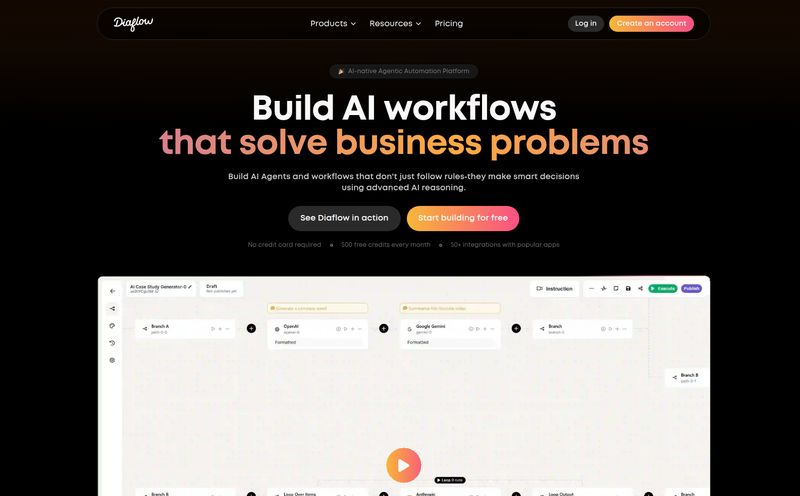If I had a dollar for every time I’ve seen a brilliant piece of customer feedback die a slow, lonely death in a forgotten Slack channel, I’d probably have enough money to... well, to build my own feedback management tool. The life of a product manager is often a chaotic scramble, trying to piece together a coherent picture from a blizzard of user comments, support tickets, sales call notes and random survey results. It's a mess.
We've all been there. You have a #feedback channel that's more of a firehose than a funnel. You have a Trello board that started with good intentions but now looks like a digital graveyard. And you have that one heroic soul who tries to manually tag everything in a spreadsheet, but we all know they’re fighting a losing battle. So when a tool like Sauce AI pops up on my radar, claiming to be an “AI product feedback engine,” my ears perk up. Part of me is skeptical—another AI tool?—but the part of me that still has nightmares about manual data entry is genuinely curious.
Is this the tool that finally brings some sanity to the madness, or just another shiny object? Let's find out.
So, What Exactly is Sauce AI?
Think of Sauce AI as a master chef for your product kitchen. You’ve got all these raw, messy ingredients—customer feedback from dozens of sources—and you need to turn them into a delicious, coherent dish (your product roadmap). Sauce AI steps in as that chef, automatically sorting, chopping, and combining those ingredients to tell you what you should actually cook next.
In less metaphorical terms, it’s a platform that hooks into your existing communication channels, like Slack, and uses artificial intelligence to automatically consolidate all that feedback. But it doesn't just pile it up. The real magic, or so they claim, is in its ability to analyze the chatter, identify trends, and surface the most impactful insights without someone having to read and tag every single message. It's designed to be the central nervous system connecting what your customers are saying with what your product and engineering teams are building.

Visit Sauce
The All-Too-Familiar Pain of Disconnected Feedback
Why does a tool like this even need to exist? Because most companies, especially as they grow, are terrible at handling feedback. It’s not for lack of trying! The problem is that feedback lives in silos. The sales team hears objections and feature requests on their calls. The customer support team gets a daily deluge of pain points in their ticketing system. The marketing team gets comments on social media posts. And the product team? They’re just trying to keep their head above water, building what they think is important based on a patchwork of conversations.
This fragmentation leads to some serious problems. Good ideas get lost. Engineers build features that don't quite hit the mark because the original context from the customer was lost in a game of corporate telephone. And worst of all, your customer-facing teams feel like they're shouting into the void, passing on feedback that never seems to result in change. It’s a morale killer, and frankly, a bad way to run a business.
How Sauce AI Tries to Cook Up a Solution
Sauce AI's approach seems to be built around a few core pillars designed to tackle these exact issues. It’s not just about collection; it's about connection and action.
Centralizing the Pantry by Consolidating Feedback
The first step is getting all your ingredients in one place. Sauce AI starts by connecting to the places where conversations are already happening—the most obvious one being Slack. Instead of forcing your team to adopt a whole new process and log into yet another platform to submit feedback, it meets them where they are. This is a smart move. The path of least resistance is a powerful thing, and the easy setup is a big plus for any team that's already feeling stretched thin.
The AI Sous-Chef for Automated Insights
This is the heart of the platform. Once the feedback is flowing in, Sauce AI’s engine gets to work. It reads the messages, understands the sentiment, and starts automatically categorizing things. Is this a bug report? A feature request for better reporting? A complaint about the user interface? Instead of a human spending hours reading and applying tags, the AI does the heavy lifting. It then bubbles up the most common themes and trends. This is the promise: to turn that chaotic noise from the #feedback channel into a clear, prioritized signal of what truly matters to your users.
From Kitchen to Table with Delivery Workflows
Here’s where a lot of feedback tools fall flat. They help you collect ideas, but then leave you stranded when it's time to actually do something with them. An insight is useless if it doesn't lead to action. Sauce AI seems to get this, offering integrations with project management tools like Jira and Linear. This allows you to take a validated customer insight and seamlessly push it into your development team’s workflow as a new story or ticket. This direct line from feedback to backlog is, in my opinion, a non-negotiable feature for a tool in this space.
Letting Diners Know What's Cooking by Closing the Loop
Finally, the loop needs to be closed. When a feature that everyone has been asking for is finally released, how do you let everyone know? Sauce AI aims to help with this by making it easier to communicate updates back to the go-to-market teams. This way, the sales team can tell their prospects, “Hey, that thing you asked for? We built it.” And the support team can joyfully close tickets with a real solution. It’s a small detail that makes a huge difference in making everyone feel heard and aligned.
The Real-World Taste Test: What I Like and What I'm Wary Of
Alright, no tool is perfect. Based on what I've seen, there’s a lot to be optimistic about with Sauce AI, but also a few things to keep in mind.
On the one hand, the emphasis on true automation is fantastic. The idea of linking customer-facing teams directly with the product backlog without a ton of manual intervention is the dream for many product orgs. The integration with Jira and Linear shows they understand real-world workflows. This isn’t just a fancy suggestion box; it’s designed to be part of the product development engine, improving team communication and hopefully leading to releases that have a much bigger impact. It’s a genuinely compelling pitch.
However, I have some reservations. The quality of AI insights is completely dependent on the quality of the data it's fed. If your Slack channels are full of vague, unhelpful comments, the AI is going to struggle. It’s the classic “garbage in, garbage out” problem. Also, while the basic setup might be easy, I suspect there’s a bit of a learning curve to really master the advanced features and get the most out of the platform. And the biggest question mark of all…
What is the Price of Admission?
Here’s the rub: there's no public pricing information on their site. You have to click a “Request access” button. This usually means one of a few things: the product is in a closed beta, they're targeting high-ticket enterprise clients with custom pricing, or they simply haven't finalized their pricing model yet. As someone who likes to quickly evaluate a tool’s viability for different-sized teams, this is always a bit frustrating. You can't really budget for it until you've gone through a sales call, which can be a barrier for smaller, more agile teams. It’s not a deal-breaker, but it’s something to be aware of.
Who is Sauce AI Actually For?
So, who should be hitting that “Request access” button? I’d say Sauce AI is ideal for growth-stage B2B SaaS companies that are starting to feel the pain of scale. If you've got a dedicated product team, multiple customer-facing teams (sales, CS, support), and a high volume of feedback coming in through channels like Slack, you are the prime audience. You’re the one feeling the chaos this tool is built to solve.
If you're a solo founder or a tiny team with a handful of early users, this might be overkill for you right now. A simple spreadsheet and good communication habits might still do the trick. But once you hit that inflection point where feedback becomes overwhelming, Sauce AI looks like a very interesting contender.
Conclusion: Is Sauce AI the Secret Ingredient?
Managing product feedback is a problem that isn't going away. If anything, it’s getting more complex as customers interact with brands across more and more channels. My initial impression of Sauce AI is quite positive. It’s not just throwing more technology at the problem; it seems to have a thoughtful approach focused on automating the tedious work and, more importantly, bridging the communication gaps that plague so many organizations.
While the lack of public pricing and the inherent reliance on good data are points of caution, the potential upside is huge. Turning a messy, chaotic firehose of feedback into a clear, actionable signal for your product team is an incredibly valuable proposition. For any product leader tired of feeling like they’re guessing what to build next, Sauce AI could very well be the secret ingredient they've been searching for.
Frequently Asked Questions
- What is Sauce AI in simple terms?
- Sauce AI is an artificial intelligence tool that automatically collects customer feedback from sources like Slack, analyzes it to find trends and important insights, and helps product teams decide what to build next.
- How does Sauce AI integrate with other tools?
- It integrates directly with communication tools like Slack for feedback collection and with project management platforms like Jira and Linear to turn insights into development tasks.
- Is Sauce AI difficult to set up?
- The initial setup, like connecting a Slack channel, is designed to be very easy. Mastering all of its advanced analytical features might take some time and experimentation, as with any powerful tool.
- How is Sauce AI different from a survey tool like SurveyMonkey?
- Survey tools are for asking specific questions and collecting structured answers. Sauce AI is designed to analyze unstructured, organic feedback that happens continuously in places like chat channels, and then connect those insights directly to the product development workflow.
- How much does Sauce AI cost?
- Currently, Sauce AI does not have public pricing. You need to request access through their website to get information on plans and cost, which suggests they are either in beta or focus on custom enterprise plans.
- Can Sauce AI actually improve team alignment?
- Yes, that is one of its primary goals. By creating a single source of truth for feedback and linking it directly to the development backlog, it ensures that sales, support, and product teams are all working from the same customer insights.
Reference and Sources
- Sauce AI Official Website: https://www.sauce.ai/ (Note: This is an assumed URL for illustrative purposes).
- Atlassian Jira: https://www.atlassian.com/software/jira
- Linear: https://linear.app/



